Changes in PRIMAP-hist v2.6_final compared to v2.5.1_final for Morocco
2024-09-24
Johannes Gütschow
Change analysis for Morocco for PRIMAP-hist v2.6_final compared to v2.5.1_final
Overview over emissions by sector and gas
The following figures show the aggregate national total emissions excluding LULUCF AR6GWP100 for the country reported priority scenario. The dotted linesshow the v2.5.1_final data.
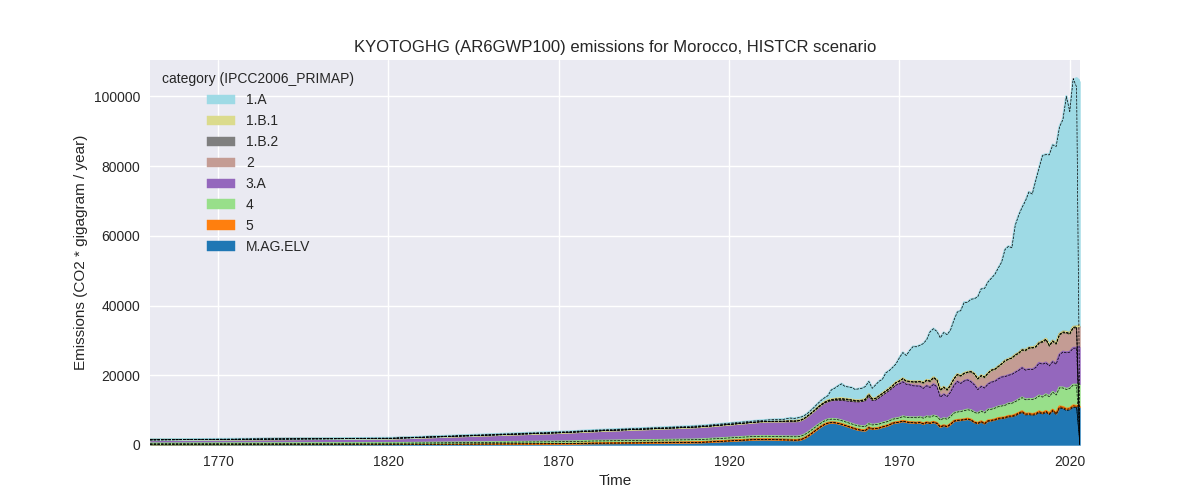
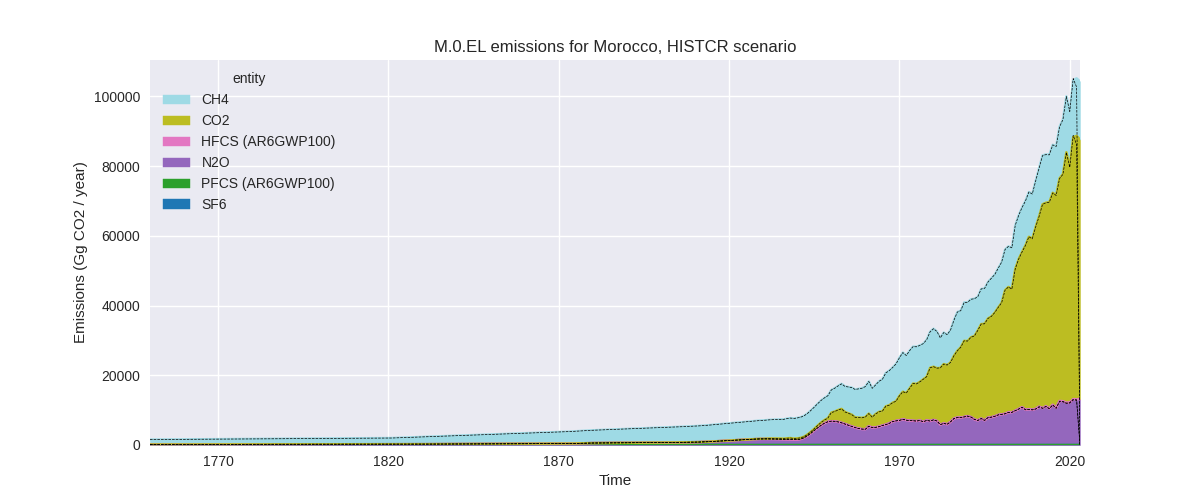
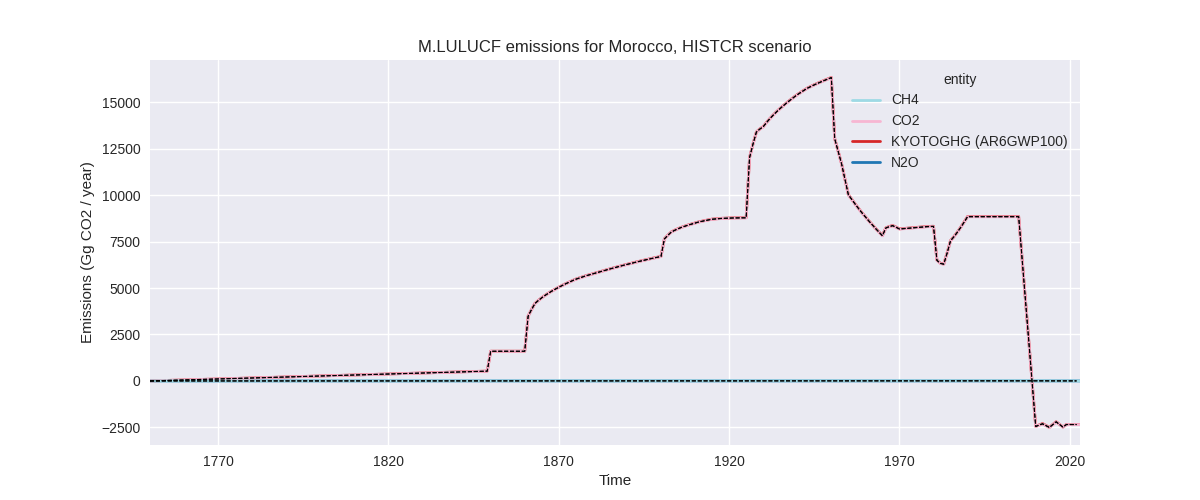
The following figures show the aggregate national total emissions excluding LULUCF AR6GWP100 for the third party priority scenario. The dotted linesshow the v2.5.1_final data.
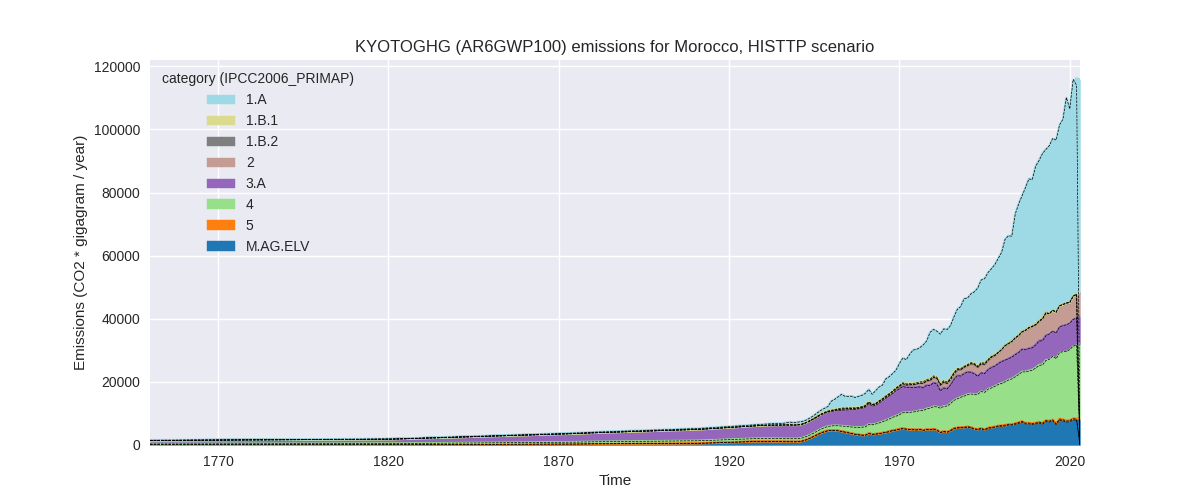
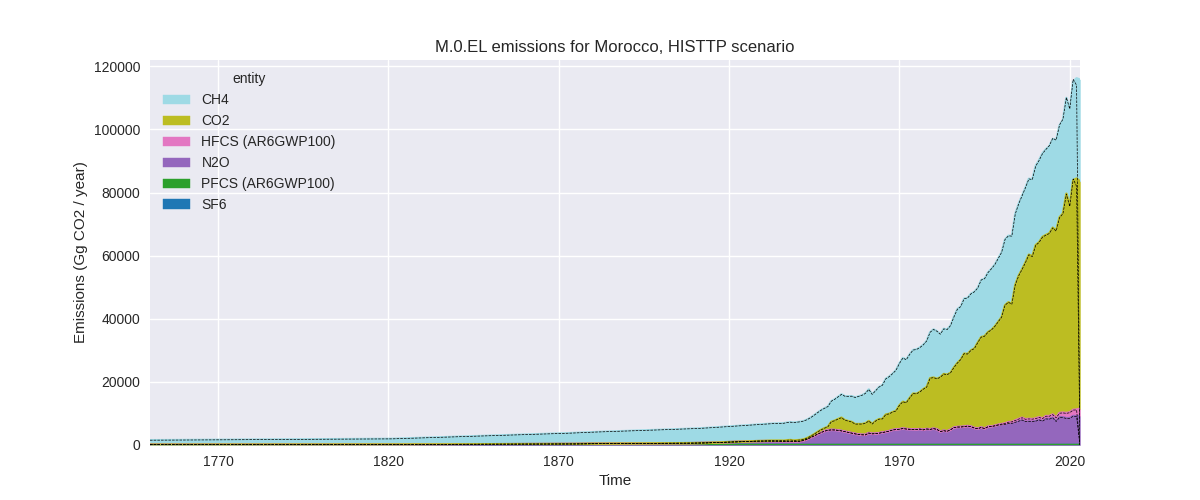
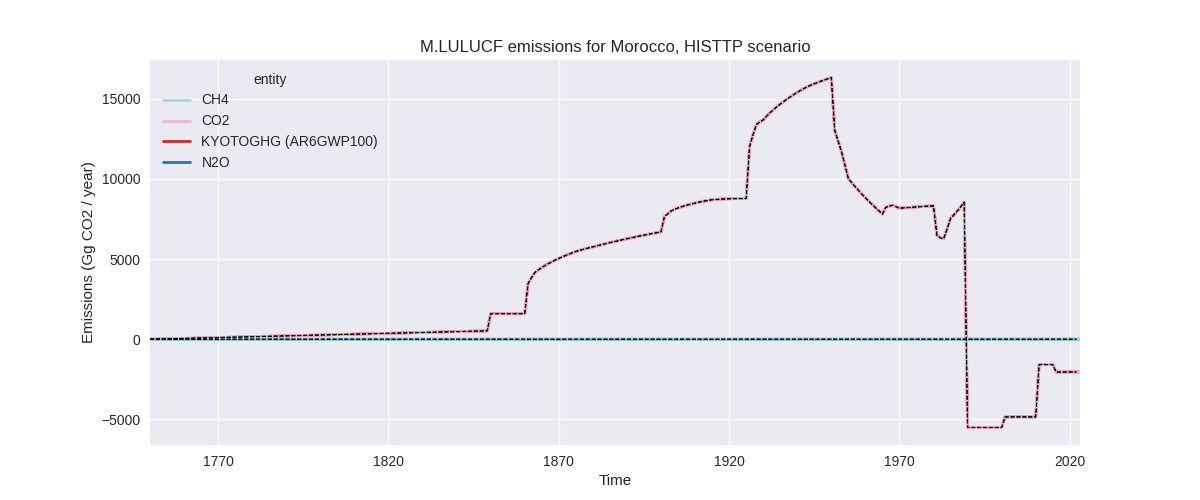
Overview over changes
In the country reported priority scenario we have the following changes for aggregate Kyoto GHG and national total emissions excluding LULUCF (M.0.EL):
- Emissions in 2022 have changed by 2.4%% (2495.48 Gg CO2 / year)
- Emissions in 1990-2022 have changed by 0.1%% (72.30 Gg CO2 / year)
In the third party priority scenario we have the following changes for aggregate Kyoto GHG and national total emissions excluding LULUCF (M.0.EL):
- Emissions in 2022 have changed by 1.9%% (2189.05 Gg CO2 / year)
- Emissions in 1990-2022 have changed by 0.0%% (22.51 Gg CO2 / year)
Most important changes per scenario and time frame
In the country reported priority scenario the following sector-gas combinations have the highest absolute impact on national total KyotoGHG (AR6GWP100) emissions in 2022 (top 5):
- 1: 1.A, CO2 with 2440.76 Gg CO2 / year (3.6%)
- 2: 5, N2O with 73.21 Gg CO2 / year (19.7%)
- 3: 4, N2O with -12.69 Gg CO2 / year (-2.9%)
- 4: 2, HFCS (AR6GWP100) with -5.52 Gg CO2 / year (-2.7%)
- 5: 4, CH4 with -0.27 Gg CO2 / year (-0.0%)
In the country reported priority scenario the following sector-gas combinations have the highest absolute impact on national total KyotoGHG (AR6GWP100) emissions in 1990-2022 (top 5):
- 1: 1.A, CO2 with 56.97 Gg CO2 / year (0.1%)
- 2: 5, N2O with 21.65 Gg CO2 / year (8.3%)
- 3: 4, N2O with -3.89 Gg CO2 / year (-1.2%)
- 4: 4, CH4 with -2.26 Gg CO2 / year (-0.1%)
- 5: 2, HFCS (AR6GWP100) with -0.17 Gg CO2 / year (-0.4%)
In the third party priority scenario the following sector-gas combinations have the highest absolute impact on national total KyotoGHG (AR6GWP100) emissions in 2022 (top 5):
- 1: 1.A, CO2 with 2345.89 Gg CO2 / year (3.6%)
- 2: 4, CH4 with -262.44 Gg CO2 / year (-1.2%)
- 3: 5, N2O with 73.21 Gg CO2 / year (19.7%)
- 4: 2, HFCS (AR6GWP100) with 30.62 Gg CO2 / year (1.5%)
- 5: 4, N2O with 1.77 Gg CO2 / year (0.3%)
In the third party priority scenario the following sector-gas combinations have the highest absolute impact on national total KyotoGHG (AR6GWP100) emissions in 1990-2022 (top 5):
- 1: 4, CH4 with -63.41 Gg CO2 / year (-0.4%)
- 2: 1.A, CO2 with 54.75 Gg CO2 / year (0.1%)
- 3: 5, N2O with 21.65 Gg CO2 / year (8.3%)
- 4: 4, N2O with 8.59 Gg CO2 / year (1.7%)
- 5: 2, HFCS (AR6GWP100) with 0.93 Gg CO2 / year (0.1%)
Notes on data changes
Here we list notes explaining important emissions changes for the country. ’' means that the following text only applies to the TP time series, while means that it only applies to the CR scenario. Otherwise the note applies to both scenarios.
- There is no new country reported data for Morocco.
- Changes to energy CO2 and are due to the updated EI data (CR, TP).
- Changes in sectors 4 and 5 are due to the removal of FAOSTAT data (CR, TP).
Changes by sector and gas
For each scenario and time frame the changes are displayed for all individual sectors and all individual gases. In the sector plot we use aggregate Kyoto GHGs in AR6GWP100. In the gas plot we usenational total emissions without LULUCF. ## country reported scenario
2022
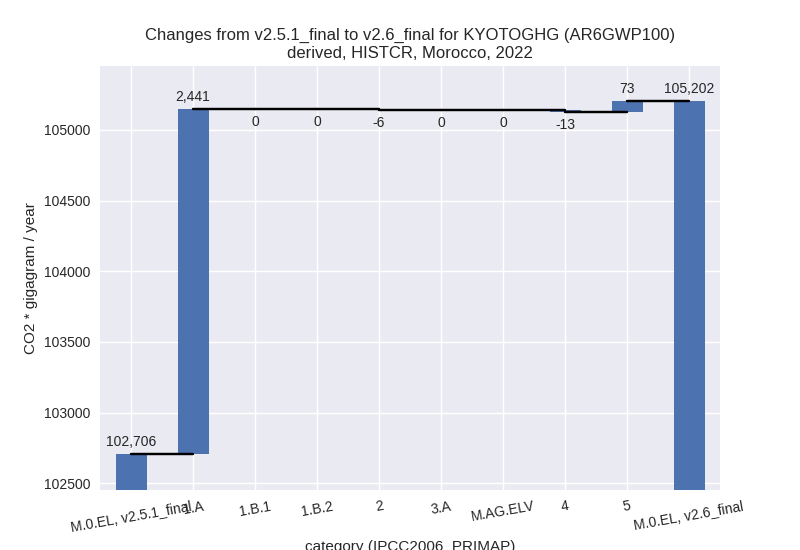
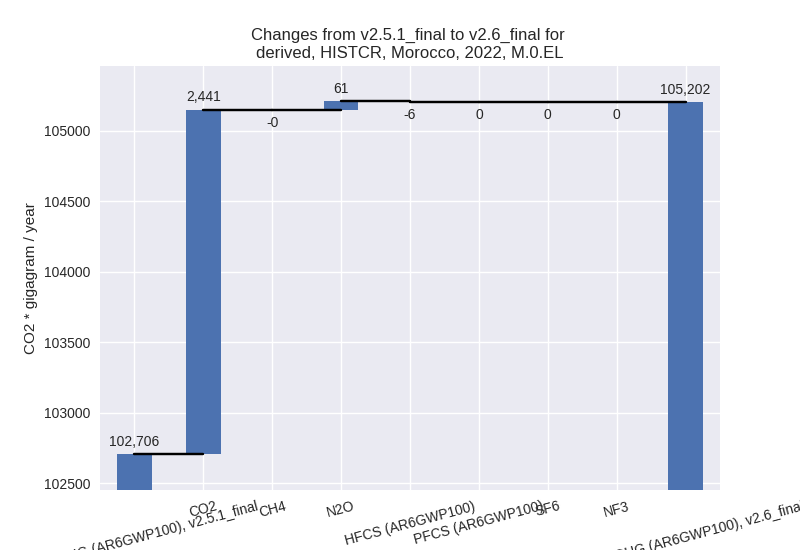
1990-2022
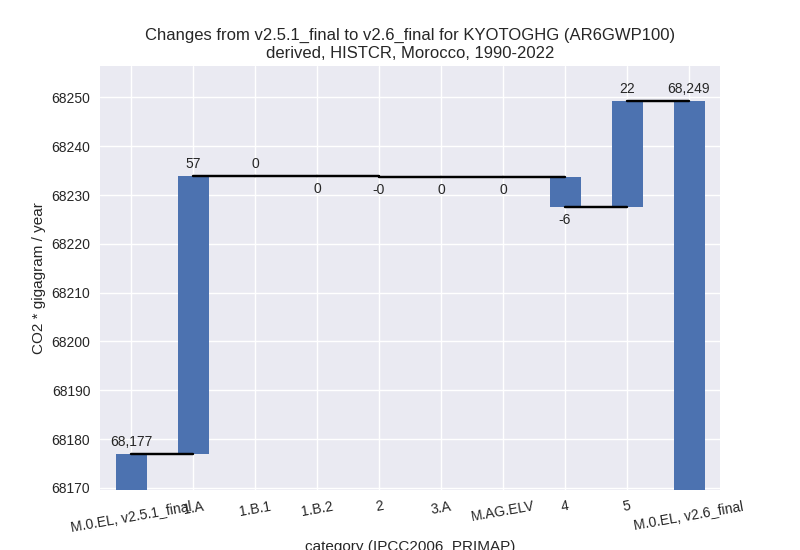
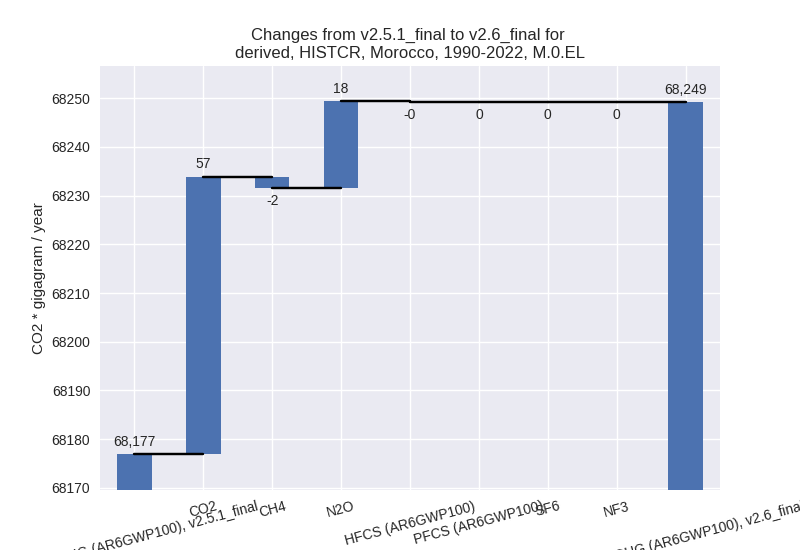
third party scenario
2022
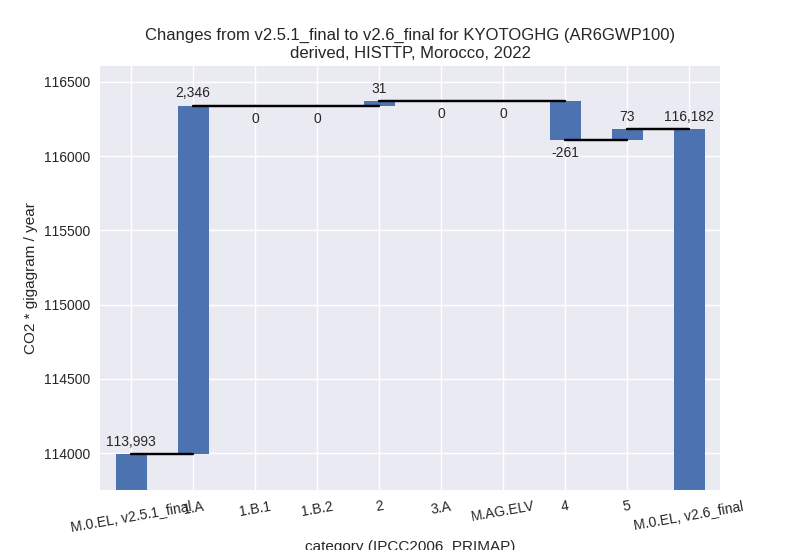
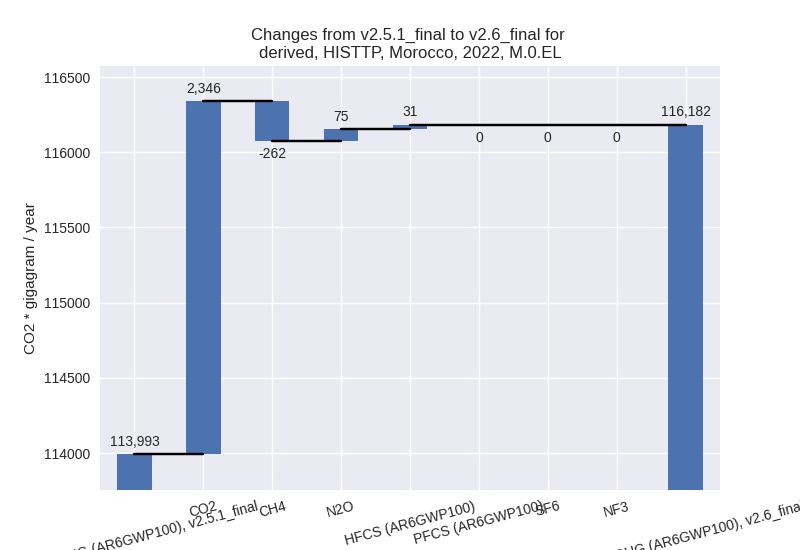
1990-2022

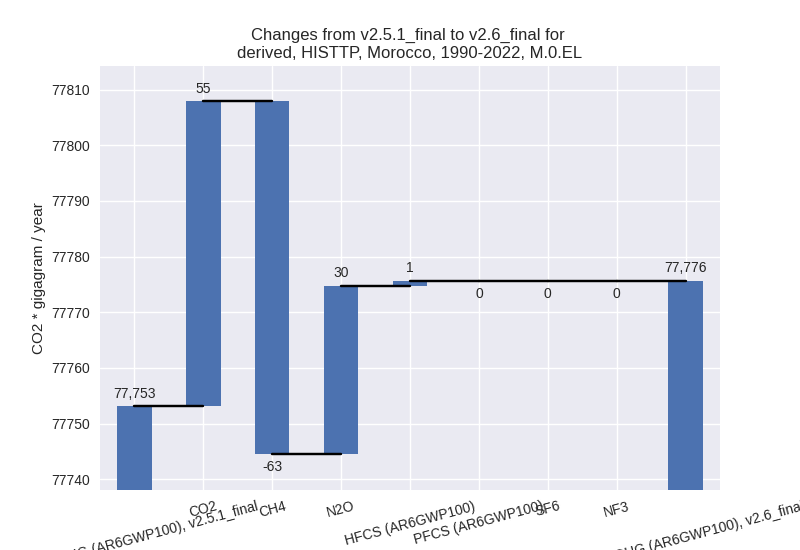
Detailed changes for the scenarios:
country reported scenario (HISTCR):
Most important changes per time frame
For 2022 the following sector-gas combinations have the highest absolute impact on national total KyotoGHG (AR6GWP100) emissions in 2022 (top 5):
- 1: 1.A, CO2 with 2440.76 Gg CO2 / year (3.6%)
- 2: 5, N2O with 73.21 Gg CO2 / year (19.7%)
- 3: 4, N2O with -12.69 Gg CO2 / year (-2.9%)
- 4: 2, HFCS (AR6GWP100) with -5.52 Gg CO2 / year (-2.7%)
- 5: 4, CH4 with -0.27 Gg CO2 / year (-0.0%)
For 1990-2022 the following sector-gas combinations have the highest absolute impact on national total KyotoGHG (AR6GWP100) emissions in 1990-2022 (top 5):
- 1: 1.A, CO2 with 56.97 Gg CO2 / year (0.1%)
- 2: 5, N2O with 21.65 Gg CO2 / year (8.3%)
- 3: 4, N2O with -3.89 Gg CO2 / year (-1.2%)
- 4: 4, CH4 with -2.26 Gg CO2 / year (-0.1%)
- 5: 2, HFCS (AR6GWP100) with -0.17 Gg CO2 / year (-0.4%)
Changes in the main sectors for aggregate KyotoGHG (AR6GWP100) are
- 1: Total sectoral emissions in 2022 are 71522.15 Gg
CO2 / year which is 68.0% of M.0.EL emissions. 2022 Emissions have
changed by 3.5% (2440.76 Gg CO2 /
year). 1990-2022 Emissions have changed by 0.1% (56.98 Gg CO2 / year). For 2022 the
changes per gas
are:

The changes come from the following subsectors:- 1.A: Total sectoral emissions in 2022 are 71280.46
Gg CO2 / year which is 99.7% of category 1 emissions. 2022 Emissions
have changed by 3.5% (2440.76 Gg CO2
/ year). 1990-2022 Emissions have changed by 0.1% (56.97 Gg CO2 / year). For 2022 the
changes per gas
are:
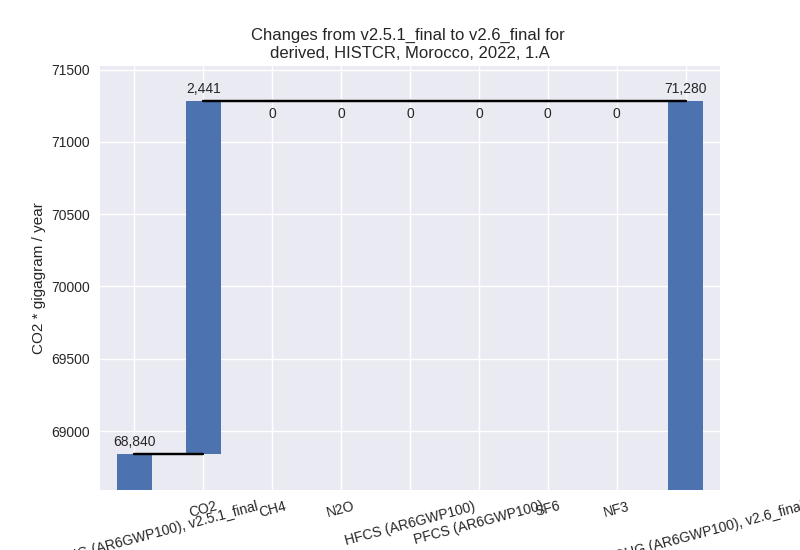
There is no subsector information available in PRIMAP-hist. - 1.B.1: Total sectoral emissions in 2022 are 9.52 Gg CO2 / year which is 0.0% of category 1 emissions. 2022 Emissions have changed by 0.0% (0.00 Gg CO2 / year). 1990-2022 Emissions have changed by 0.0% (0.01 Gg CO2 / year).
- 1.B.2: Total sectoral emissions in 2022 are 232.17 Gg CO2 / year which is 0.3% of category 1 emissions. 2022 Emissions have changed by 0.0% (0.00 Gg CO2 / year). 1990-2022 Emissions have changed by 0.0% (0.00 Gg CO2 / year).
- 1.A: Total sectoral emissions in 2022 are 71280.46
Gg CO2 / year which is 99.7% of category 1 emissions. 2022 Emissions
have changed by 3.5% (2440.76 Gg CO2
/ year). 1990-2022 Emissions have changed by 0.1% (56.97 Gg CO2 / year). For 2022 the
changes per gas
are:
- 2: Total sectoral emissions in 2022 are 5803.92 Gg CO2 / year which is 5.5% of M.0.EL emissions. 2022 Emissions have changed by -0.1% (-5.53 Gg CO2 / year). 1990-2022 Emissions have changed by -0.0% (-0.17 Gg CO2 / year).
- M.AG: Total sectoral emissions in 2022 are 21369.64 Gg CO2 / year which is 20.3% of M.0.EL emissions. 2022 Emissions have changed by 0.0% (0.00 Gg CO2 / year). 1990-2022 Emissions have changed by 0.0% (0.00 Gg CO2 / year).
- 4: Total sectoral emissions in 2022 are 6061.60 Gg CO2 / year which is 5.8% of M.0.EL emissions. 2022 Emissions have changed by -0.2% (-12.97 Gg CO2 / year). 1990-2022 Emissions have changed by -0.1% (-6.15 Gg CO2 / year).
- 5: Total sectoral emissions in 2022 are 444.62 Gg
CO2 / year which is 0.4% of M.0.EL emissions. 2022 Emissions have
changed by 19.7% (73.21 Gg CO2 /
year). 1990-2022 Emissions have changed by 8.3% (21.65 Gg CO2 / year). For 2022 the
changes per gas
are:

For 1990-2022 the changes per gas are: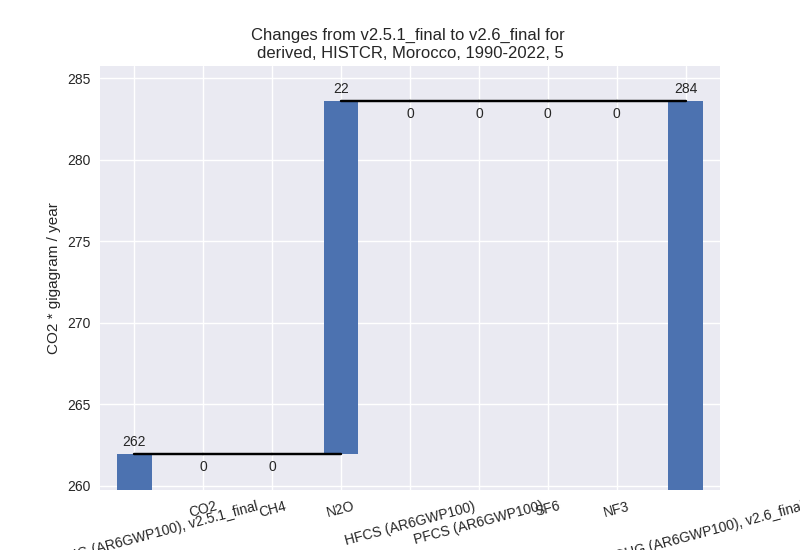
third party scenario (HISTTP):
Most important changes per time frame
For 2022 the following sector-gas combinations have the highest absolute impact on national total KyotoGHG (AR6GWP100) emissions in 2022 (top 5):
- 1: 1.A, CO2 with 2345.89 Gg CO2 / year (3.6%)
- 2: 4, CH4 with -262.44 Gg CO2 / year (-1.2%)
- 3: 5, N2O with 73.21 Gg CO2 / year (19.7%)
- 4: 2, HFCS (AR6GWP100) with 30.62 Gg CO2 / year (1.5%)
- 5: 4, N2O with 1.77 Gg CO2 / year (0.3%)
For 1990-2022 the following sector-gas combinations have the highest absolute impact on national total KyotoGHG (AR6GWP100) emissions in 1990-2022 (top 5):
- 1: 4, CH4 with -63.41 Gg CO2 / year (-0.4%)
- 2: 1.A, CO2 with 54.75 Gg CO2 / year (0.1%)
- 3: 5, N2O with 21.65 Gg CO2 / year (8.3%)
- 4: 4, N2O with 8.59 Gg CO2 / year (1.7%)
- 5: 2, HFCS (AR6GWP100) with 0.93 Gg CO2 / year (0.1%)
Changes in the main sectors for aggregate KyotoGHG (AR6GWP100) are
- 1: Total sectoral emissions in 2022 are 68691.83 Gg
CO2 / year which is 59.1% of M.0.EL emissions. 2022 Emissions have
changed by 3.5% (2345.89 Gg CO2 /
year). 1990-2022 Emissions have changed by 0.1% (54.76 Gg CO2 / year). For 2022 the
changes per gas
are:
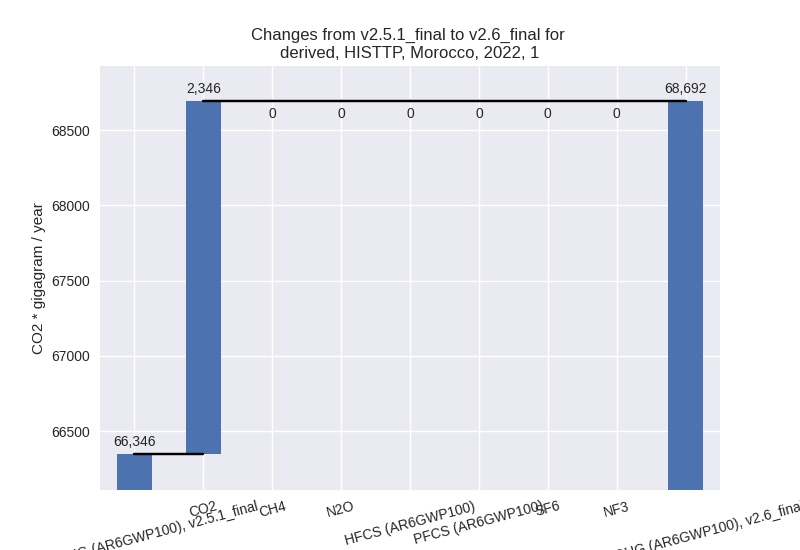
The changes come from the following subsectors:- 1.A: Total sectoral emissions in 2022 are 68532.27
Gg CO2 / year which is 99.8% of category 1 emissions. 2022 Emissions
have changed by 3.5% (2345.89 Gg CO2
/ year). 1990-2022 Emissions have changed by 0.1% (54.75 Gg CO2 / year). For 2022 the
changes per gas
are:
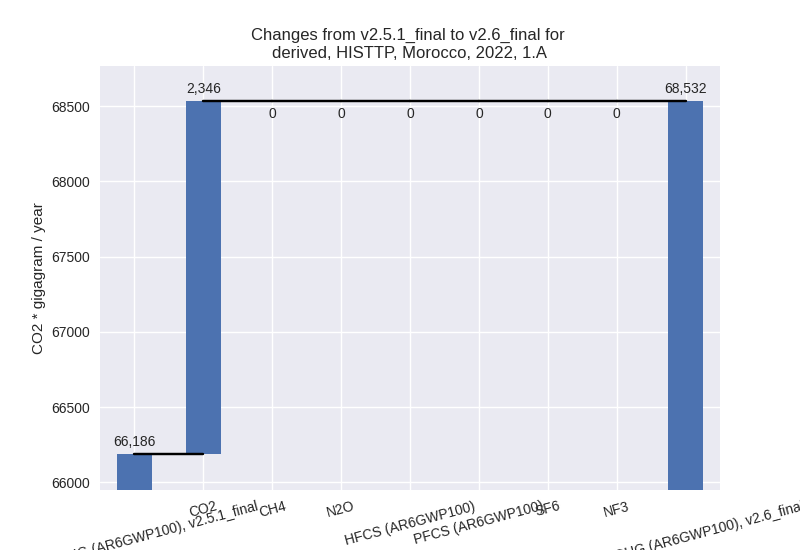
There is no subsector information available in PRIMAP-hist. - 1.B.1: Total sectoral emissions in 2022 are 55.25 Gg CO2 / year which is 0.1% of category 1 emissions. 2022 Emissions have changed by 0.0% (0.00 Gg CO2 / year). 1990-2022 Emissions have changed by 0.0% (0.01 Gg CO2 / year).
- 1.B.2: Total sectoral emissions in 2022 are 104.31 Gg CO2 / year which is 0.2% of category 1 emissions. 2022 Emissions have changed by 0.0% (0.00 Gg CO2 / year). 1990-2022 Emissions have changed by 0.0% (0.00 Gg CO2 / year).
- 1.A: Total sectoral emissions in 2022 are 68532.27
Gg CO2 / year which is 99.8% of category 1 emissions. 2022 Emissions
have changed by 3.5% (2345.89 Gg CO2
/ year). 1990-2022 Emissions have changed by 0.1% (54.75 Gg CO2 / year). For 2022 the
changes per gas
are:
- 2: Total sectoral emissions in 2022 are 7440.80 Gg CO2 / year which is 6.4% of M.0.EL emissions. 2022 Emissions have changed by 0.4% (30.61 Gg CO2 / year). 1990-2022 Emissions have changed by 0.0% (0.92 Gg CO2 / year).
- M.AG: Total sectoral emissions in 2022 are 16432.08 Gg CO2 / year which is 14.1% of M.0.EL emissions. 2022 Emissions have changed by 0.0% (0.00 Gg CO2 / year). 1990-2022 Emissions have changed by 0.0% (0.00 Gg CO2 / year).
- 4: Total sectoral emissions in 2022 are 23172.42 Gg CO2 / year which is 19.9% of M.0.EL emissions. 2022 Emissions have changed by -1.1% (-260.67 Gg CO2 / year). 1990-2022 Emissions have changed by -0.3% (-54.82 Gg CO2 / year).
- 5: Total sectoral emissions in 2022 are 444.62 Gg
CO2 / year which is 0.4% of M.0.EL emissions. 2022 Emissions have
changed by 19.7% (73.21 Gg CO2 /
year). 1990-2022 Emissions have changed by 8.3% (21.65 Gg CO2 / year). For 2022 the
changes per gas
are:
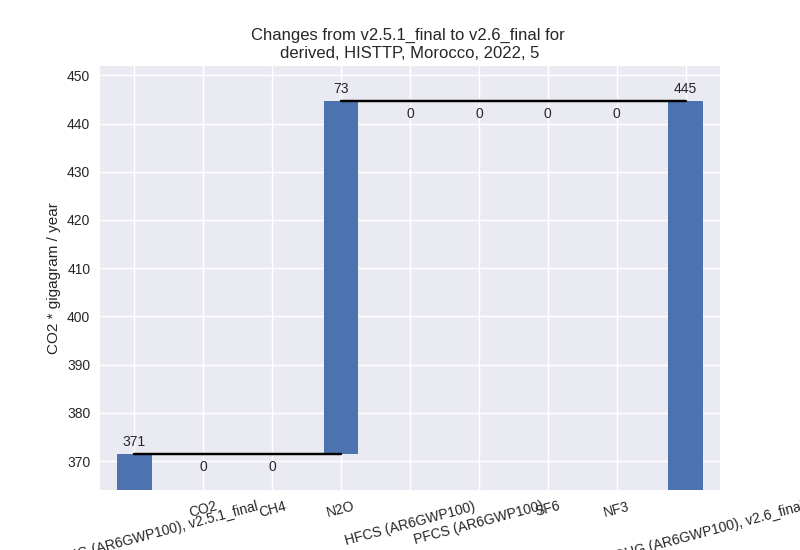
For 1990-2022 the changes per gas are: